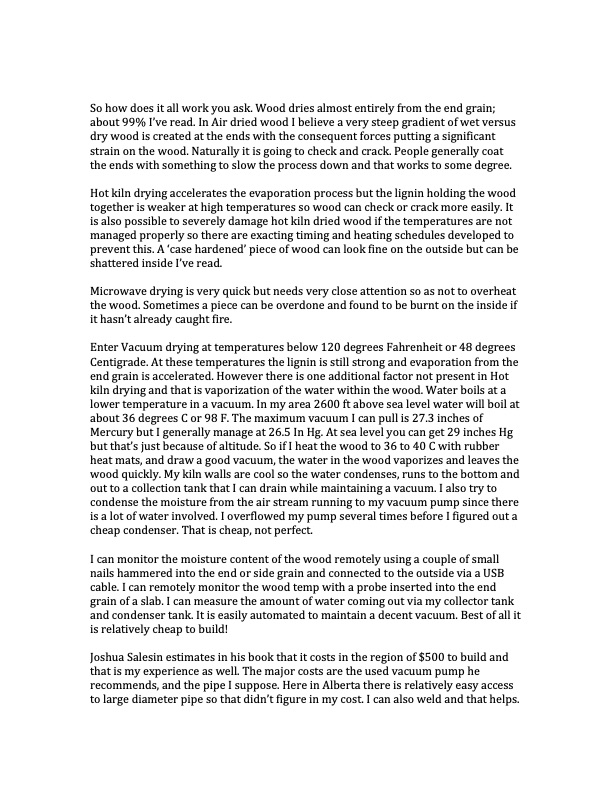
PDF Publication Title:
Text from PDF Page: 002
So how does it all work you ask. Wood dries almost entirely from the end grain; about 99% I’ve read. In Air dried wood I believe a very steep gradient of wet versus dry wood is created at the ends with the consequent forces putting a significant strain on the wood. Naturally it is going to check and crack. People generally coat the ends with something to slow the process down and that works to some degree. Hot kiln drying accelerates the evaporation process but the lignin holding the wood together is weaker at high temperatures so wood can check or crack more easily. It is also possible to severely damage hot kiln dried wood if the temperatures are not managed properly so there are exacting timing and heating schedules developed to prevent this. A ‘case hardened’ piece of wood can look fine on the outside but can be shattered inside I’ve read. Microwave drying is very quick but needs very close attention so as not to overheat the wood. Sometimes a piece can be overdone and found to be burnt on the inside if it hasn’t already caught fire. Enter Vacuum drying at temperatures below 120 degrees Fahrenheit or 48 degrees Centigrade. At these temperatures the lignin is still strong and evaporation from the end grain is accelerated. However there is one additional factor not present in Hot kiln drying and that is vaporization of the water within the wood. Water boils at a lower temperature in a vacuum. In my area 2600 ft above sea level water will boil at about 36 degrees C or 98 F. The maximum vacuum I can pull is 27.3 inches of Mercury but I generally manage at 26.5 In Hg. At sea level you can get 29 inches Hg but that’s just because of altitude. So if I heat the wood to 36 to 40 C with rubber heat mats, and draw a good vacuum, the water in the wood vaporizes and leaves the wood quickly. My kiln walls are cool so the water condenses, runs to the bottom and out to a collection tank that I can drain while maintaining a vacuum. I also try to condense the moisture from the air stream running to my vacuum pump since there is a lot of water involved. I overflowed my pump several times before I figured out a cheap condenser. That is cheap, not perfect. I can monitor the moisture content of the wood remotely using a couple of small nails hammered into the end or side grain and connected to the outside via a USB cable. I can remotely monitor the wood temp with a probe inserted into the end grain of a slab. I can measure the amount of water coming out via my collector tank and condenser tank. It is easily automated to maintain a decent vacuum. Best of all it is relatively cheap to build! Joshua Salesin estimates in his book that it costs in the region of $500 to build and that is my experience as well. The major costs are the used vacuum pump he recommends, and the pipe I suppose. Here in Alberta there is relatively easy access to large diameter pipe so that didn’t figure in my cost. I can also weld and that helps.PDF Image | Vacuum Kiln Wood Drying

PDF Search Title:
Vacuum Kiln Wood DryingOriginal File Name Searched:
Vacuum-Kiln-Wood-Drying-PDF.pdfDIY PDF Search: Google It | Yahoo | Bing
5,000 BF Shipping Container Lumber Dry Kiln For Quality Lumber The 5,000 BF container kiln consists of one 40 foot high-cube aluminum shipping container... More Info
Shipping Container Lumber Dry Kilns by Global Energy Global Energy designed and developed the container kiln back in 1991. The purpose is to give access to portable sawmill owners, furniture makers, and small business the value added profit of dry kiln lumber and quality hardwoods... More Info
Vacuum Kiln Conversion Kit for Lumber and Wood Dry Kilns Convert your existing conventional dry kiln into a fast drying vacuum kiln. Similar to vacuum bagging in the boat building and aircraft industry, we have come up with a proprietary process which allows you to build a very simple vacuum kiln at a fraction of the price, and without the intensive conventional metal chamber structure... More Info
Vacuum Pump Cart System for Bagging Clamping Wood Drying and more Vacuum Cart with 2HP Pump and Dual Pistons with multiple multiplex vacuum ports and liquid reservoir... More Info
Vacuum Bagging Basics Vacuum bagging is a method of clamping, which has traditionally been used in the composites industry, but can also be used for vacuum drying materials, including wood products... More Info
| CONTACT TEL: 608-238-6001 Email: greg@globalmicroturbine.com | RSS | AMP |